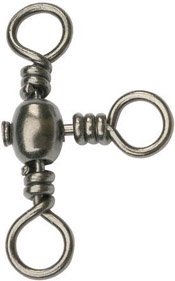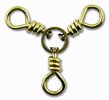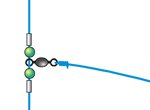- Home
- Fishing Gear
- Fishing Swivels
Fishing Swivels - the Good, the Bad and the Just Plain Ugly
Unless you have one or more fishing swivels tied into your gear at some point, the line will twist and may eventually kink to the point of failure. They're essential then, these little chaps ...
Line twists develop both during the cast and on the retrieve, and particularly when spinning or trolling a lure astern.
Swivels allow any line twists to unwind before they can develop to the extent that they weaken your line or hamper your casting ability.
Or so they should.
Cheap ones, although they may appear to do the job when twiddled between your fingers, are much less likely to do so when under load.
Once they lock solid they're worse than useless, as not only do they allow the dreaded kinks to develop, they form a weak link in your line that wouldn't otherwise be there.
There are two design differences in the internal workings of fishing swivels:~
- plain bearings;
- ball bearings;
They're produced in several configurations:~
- barrel swivels;
- crane swivels;
- ball-bearing swivels;
- aussie swivels;
- snap swivels;
- 3-way swivels;
Let's take a look at each of these:
Barrel Swivels
These have a nickel-plated bronze barrel swaged around a pair of brass wire pins. One end of the pin is twisted to form a line attachment eye, and the other has a formed head to locate it within the barrel.
This is a low-cost design and we shouldn't expect too much from them in terms of performance. The metal-to-metal bearing surfaces aren't machined in any way, so friction when under load is high.
As a result, when there's any real tension in your line, they won't solve any line twist problems. They're OK for making connections when line twist is likely to be an issue, but you won't find them in my tackle box.
Their popularity is entirely due to their cheapness, but my advice would be to spend a little more on the much more efficient crane swivels.
How to tell a barrel swivel from a crane swivel?
Easy, just look for the twisted wire eyes. If it has them, it's a barrel swivel - if it doesn't, it isn't.
Crane Swivels
Sometimes called rolling swivels, these mid-range fishing swivels are a derivation of the barrel swivels but differ from them in their construction. These are usually manufactured with nickel-plated bronze barrel, within which both ends of the wire pins now terminate.
The bearing surfaces are larger, friction losses proportionally lower, as a result of which they're both stronger and more efficient than barrel swivels.
They're a little more expensive than barrel swivels, but much better value for money in my view.
Superior versions are available in stainless steel. These are designed and engineered to a high standard, as a result of which they're smaller and stronger than the standard models.
But whichever version you choose, crane swivels are ideal for all your shore fishing needs, and for most boat fishing applications too.
The exceptions?
Big-game fishing, when one of the two variants described next will be necessary to deal with the power of a hard-charging gamefish.
Ball-Bearing Swivels
These high-end swivels are designed to operate effectively even when under the loads imposed by the fast-swimming gamefish of the open ocean.
They're manufactured in stainless steel with internal ball bearings, enabling them to turn freely under all loads within their range.
Their high quality engineering and materials makes them expensive, but their superior strength and performance means they're worth it.
What to look for?
Make sure the rings are closed with a welded joint to avoid any risk of them opening out.
Aussie Swivels
These are the strongest of all swivels, and are ideal for trolling for the largest tuna and gamefish.

Machined from solid brass and with integral eyes, they're exceptionally durable and reliable.
But they're also made in small sizes which makes them suitable for connecting your trolling leader to your main line.
Depending on the type of line guides on your trolling rod, you may find that you'll be able to wind them directly onto your reel.
Snap Swivels
All of the foregoing designs of fishing swivels can be fitted with a connecting link, when they become known as snap swivels.
The whole purpose of snap swivels is to avoid the need to tie a knot, or make a crimped connection, when you want to change your leader, your terminal tackle or the lead weight on the end of it.
Yes, it's quick and convenient but sometimes the less visible knot or crimped connection is worth spending a little extra time on.
Some anglers use snap links for attaching their lures, but I really don't like this idea at all - for the following reasons ...
- snap links are far too visible and spoil the whole appearance of the lure;
- Their bulk will create disturbance over the lure, possibly spoiling its action. This I think is especially true when using a plug with a diving vane.
It's much better in my view to use one of the recognised saltwater fishing knots or a crimped connection.
3-Way Fishing Swivels
These are often used in drift fishing situations where there's a need to place the bait or lure some distance from the sinker, such as when jigging, or using a flying collar rig.



There are several variants, three of which are shown here.
I have to say I'm not overly keen on any of them.
They just don't look right - the engineer in me says that the applied forces should be in line, not at an angle where they will try to bend the component.

I much prefer the approach shown here, using a single swivel fixed between crimps and beads.
Apart from the improved engineering, it's much less prone to tangles than a three-way swivel.
Crane swivels are ideal for this, particularly those with a round eye at one end and a diamond eye at the other.
Looking After Your Fishing Swivels
Just as you do your hooks and lures, rinse them off in fresh water after a day on the briny.
Even so, they won't last forever. Fishing swivels do get a bit tired after a while, so it's best to replace them periodically before they unexpectedly let go - just when you'd rather they hadn't.
Recent Articles
-
Sea Fishing Rods and Reels Must Be Compatible for a Balanced Outfit
Mar 08, 21 08:30 AM
A quality reel fitted to a quality rod doesn't necessarily make it a quality outfit. Your fishing rods and reels have to be properly matched if you're to get the best out of them, and here’s how -
Essential Lure Fishing Tips That All Saltwater Anglers Should Know
Mar 08, 21 04:51 AM
Which single lure fishing tip applies to trolling, jigging, baitcasting, spinning, fly fishing and any other branch of lure fishing? Well, it is the one at the top of this list -
Vital Jig Fishing Tips That You Really Cannot Afford To Miss!
Mar 07, 21 10:20 AM
Essential jig fishing tips to help you select the right lure for successful jig fishing, together with the techniques required to get the most out of your jig fishing outfit
























New! Comments
Have your say about what you've just read! Leave me a comment in the box below.